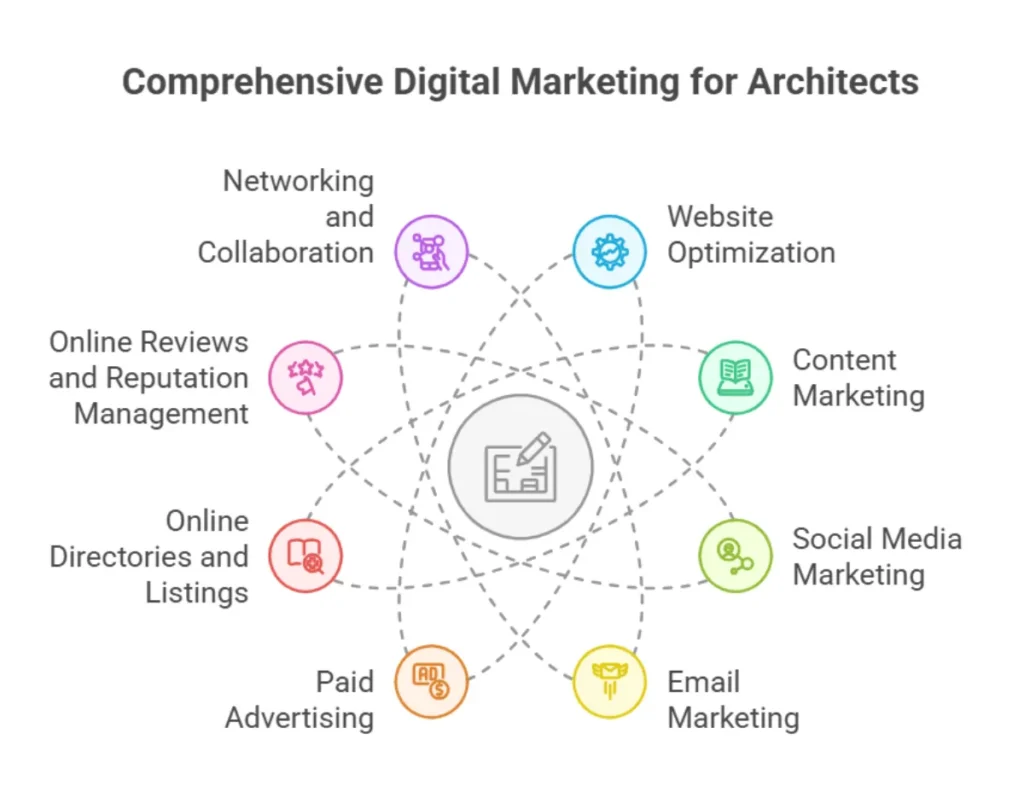Introduction
Digital Marketing for Architecture Firms must adapt to stay competitive. Traditionally, architects relied on word-of-mouth, print ads, and networking events to attract clients. While these methods are still valuable, the digital landscape plays a crucial role in business growth.
Today, clients search for architects online, compare portfolios, and read reviews before making decisions. Without a strong digital presence, firms risk losing potential projects to competitors with better online visibility. Digital marketing offers architecture firms a way to showcase their expertise, connect with clients, and build a recognizable brand.
This guide explores the essential digital marketing strategies that can help architecture firms expand their reach, attract new clients, and position themselves as industry leaders.
Understand the main Concept in Digital Marketing for Architecture Firms
Digital marketing uses online channels to promote a business, attract clients, and build brand awareness. Architecture firms leverage websites, social media, search engines, and email marketing to showcase expertise and connect with potential clients.
Traditionally, architecture firms generated business through print advertising, direct referrals, and networking events. While these methods hold value, the industry has shifted toward digital platforms. Clients now research firms online, browse project portfolios, and engage with content before reaching out.
Embracing digital marketing allows architecture firms to stay relevant in a competitive market. A well-planned strategy increases visibility and builds credibility and trust, helping firms attract and retain clients more effectively.
Benefits of Digital Marketing for Architecture Firms
Enhanced Visibility and Reach
Digital marketing allows architecture firms to expand beyond local boundaries. A well-optimized website and active social media presence help attract clients from different regions, even internationally. Through search engine optimization (SEO) and targeted online ads, firms can appear in front of potential clients actively searching for architectural services.
Cost-Effective Marketing
Traditional advertising methods—print ads, billboards, and trade shows—can be expensive and offer limited reach. Digital marketing provides more affordable options, such as social media marketing, content creation, and pay-per-click (PPC) ads, and it often yields better returns. Firms can allocate budgets more efficiently and measure results in real-time.
Improved Client Engagement
Online platforms enable direct communication between architecture firms and potential clients. Social media, email newsletters, and blog content encourage interaction, allowing firms to address inquiries, share project updates, and build relationships. Real-time feedback and engagement help firms refine their messaging and better understand client needs.
Data-Driven Decision Making
One of digital marketing’s greatest advantages is access to analytics. Tools like Google Analytics and social media insights help firms track website traffic, engagement rates, and conversion metrics. This data allows firms to adjust their strategies, focus on what works, and continuously improve their marketing efforts for better results.
Key Digital Marketing Strategies for Architecture Firms

Website Optimization
A strategically designed website serves as the backbone of any digital marketing strategy. It serves as a firm’s online portfolio, helping potential clients learn about services, view past projects, and make contact.
- User Experience (UX) Design – A clean, intuitive layout ensures visitors can navigate easily. A well-structured site should reflect the firm’s design philosophy while making information accessible. [Read Full Article]
- Mobile Responsiveness – Many users browse on smartphones and tablets. A mobile-friendly website ensures seamless access across all devices, improving user experience and search rankings.
- Search Engine Optimization (SEO) – Incorporating relevant keywords, meta descriptions, and high-quality content helps improve visibility on search engines like Google. This increases the chances of attracting clients searching for architecture services.
- Portfolio Showcase – High-resolution images, case studies, and project descriptions demonstrate expertise and build credibility. A well-organized portfolio highlights design skills and past successes.
A strong website creates a lasting impression and establishes trust, making it crucial to an architecture firm’s digital marketing efforts.
Content Marketing
Content marketing helps architecture firms establish authority, engage audiences, and attract potential clients. By sharing valuable insights, firms can position themselves as industry experts while improving online visibility.
Blogging
Writing blog posts on industry trends, sustainable design, and project spotlights helps educate and engage potential clients. Optimized blog content also improves search rankings, making it easier for clients to discover the firm online.
Video Content
Videos provide a dynamic way to showcase architectural work. Virtual tours of completed projects, behind-the-scenes design processes, and client testimonials create an immersive experience, helping prospects connect with the firm’s expertise and vision.
Whitepapers and E-books
In-depth resources on architectural innovations, design methodologies, and case studies help firms establish thought leadership. Offering these materials in exchange for contact information can also generate leads and build a strong client base.
By consistently producing high-quality content, architecture firms can strengthen their reputation, attract new clients, and stay ahead in a competitive market.
Social Media Marketing
Social media platforms give architecture firms a powerful way to showcase their work, connect with clients, and build a strong brand presence. A strategic approach helps firms engage their audience while expanding their reach.
Platform Selection
Choosing the right platforms is essential. Instagram is ideal for sharing high-quality images of completed projects, while LinkedIn helps firms network with industry professionals. Pinterest can attract design-focused clients, and Facebook allows for broader community engagement.
Content Strategy
A mix of engaging content keeps followers interested. Architecture firms can share:
- Project updates and behind-the-scenes glimpses
- Client testimonials to build trust
- Industry news and design trends to showcase expertise
Community Engagement
Interacting with followers builds stronger relationships. To engage potential clients, firms should respond to comments, participate in industry discussions, and host live Q&A sessions.
A well-planned social media strategy helps architecture firms stay visible, attract leads, and position themselves as leaders in the field.
Email Marketing
Email marketing allows architecture firms to maintain relationships with potential and existing clients, keeping them informed and engaged. A well-crafted email strategy can drive website traffic, showcase projects, and nurture leads.
Newsletter Campaigns
Regular newsletters featuring recent projects, blog posts, and industry insights help keep subscribers engaged. Including high-quality visuals and compelling subject lines increase open rates and interaction.
Personalized Outreach
Tailoring emails based on client interests or past interactions increases engagement. For example, sending design inspiration to prospective homeowners or technical insights to developers makes the content more relevant and effective.
Email marketing remains a cost-effective way to stay top of mind. It provides valuable updates while reinforcing the firm’s expertise and credibility.
Paid Advertising
Paid advertising helps architecture firms reach a targeted audience quickly, increasing visibility and generating leads. By investing in strategic online ads, firms can attract potential clients searching for architectural services.
Pay-Per-Click (PPC) Advertising
Platforms like Google Ads allow firms to target specific keywords related to architectural services. When users search for terms like “modern home architects” or “commercial building designers,” PPC ads ensure the firm appears at the top of search results.
Social Media Ads
Paid campaigns on platforms like Facebook, Instagram, and LinkedIn help firms reach specific demographics. Ads featuring high-quality project images, client testimonials, or video tours can drive engagement and attract inquiries.
Using targeted paid advertising, architecture firms can maximize their reach, attract more qualified leads, and gain a competitive edge in the digital space.
Online Directories and Listings
Being listed in online directories helps architecture firms improve their visibility and credibility. These platforms make it easier for potential clients to discover and contact firms directly.
Google My Business
Optimizing a Google My Business profile ensures the firm appears in local search results and Google Maps. A complete profile with accurate contact details, business hours, and high-quality images increases trust and engagement.
Industry-Specific Directories
Architecture-focused platforms like Architizer, Houzz, and Designboom help firms connect with a targeted audience. Listing on these sites boosts online presence and allows potential clients to explore projects and services.
Consistently updating directory listings with fresh content, images, and client reviews strengthens credibility and enhances search rankings, making it easier for architecture firms to attract new business.
Online Reviews and Reputation Management
A strong online reputation helps architecture firms build trust and attract more clients. Effectively managing reviews ensures a positive brand image and reinforces credibility.
Client Testimonials
Showcasing testimonials on the firm’s website and social media builds confidence among potential clients. Positive feedback highlights past successes and reassures prospects about the firm’s expertise.
Review Platforms
Platforms like Google Reviews, Houzz, and Yelp influence client decisions. Encouraging satisfied clients to leave reviews and responding professionally to positive and negative feedback demonstrates a commitment to client satisfaction.
By actively managing their online reputation, architecture firms can enhance their credibility, improve client relationships, and increase their chances of winning new projects.
Networking and Collaboration
Building relationships within the industry and beyond can help architecture firms expand their reach and establish credibility. Digital platforms make connecting, collaborating, and sharing expertise more effortless.
Webinars and Online Workshops
Hosting virtual events allows firms to showcase their knowledge on topics like sustainable design, urban planning, or innovative materials. These sessions attract potential clients, industry peers, and media attention while positioning the firm as a thought leader.
Partnerships
Collaborating with complementary businesses—interior designers, real estate developers, and construction firms—creates new marketing opportunities. Joint content, cross-promotions, and co-hosted events help expand audiences and generate more leads.
By leveraging digital networking and strategic partnerships, architecture firms can enhance their visibility, strengthen industry connections, and attract high-quality projects.
Measuring the Success Efforts of Digital Marketing for Architecture Firms
Tracking and analyzing marketing performance helps architecture firms refine their strategies and maximize results. By using data-driven insights, firms can adjust their approach for better engagement and lead generation.
Key Performance Indicators (KPIs)
Monitoring metrics like website traffic, conversion rates, social media engagement, and email open rates helps firms understand what’s working and where improvements are needed.
Analytics Tools
Tools like Google Analytics, Facebook Insights, and LinkedIn Analytics provide valuable data on audience behavior, helping firms make informed decisions about content and advertising strategies.
Continuous Improvement
Reviewing performance metrics regularly allows firms to refine their marketing strategies. Testing different ad formats, content styles, and SEO techniques ensures ongoing optimization for better results.
By consistently measuring and adjusting digital marketing efforts, architecture firms can improve their online presence, attract more clients, and stay ahead of the competition.
Challenges and Considerations
While digital marketing offers significant benefits, architecture firms must navigate specific challenges to achieve long-term success.
Keeping Up with Industry Trends
Digital marketing is constantly evolving. Staying updated on SEO changes, social media trends, and emerging technologies ensures firms remain competitive and maximize their online presence.
Resource Allocation
Balancing time and budget across multiple marketing channels can be challenging. Firms must prioritize strategies that offer the highest return on investment, whether through in-house efforts or outsourcing to digital marketing professionals.
Authenticity
Maintaining a firm’s unique voice and design philosophy across all digital platforms is essential. Consistency in branding, messaging, and content helps build trust and strengthens the firm’s identity.
By addressing these challenges proactively, architecture firms can create a sustainable and effective digital marketing strategy that supports long-term growth.
Conclusion & Final Thoughts
Digital marketing is essential for architecture firms looking to expand their reach, attract new clients, and stay competitive in a changing industry. A well-planned strategy—incorporating website optimization, content marketing, social media engagement, and paid advertising—helps firms showcase their expertise and build credibility.
By leveraging data-driven insights and continuously refining their approach, firms can maximize their marketing efforts for long-term success. Embracing digital marketing increases visibility, strengthens client relationships, and positions a firm as an industry leader.
To thrive in today’s digital landscape, architecture firms should develop a tailored digital marketing plan that aligns with their goals and brand identity. Taking proactive steps now will ensure continued growth and success in the years ahead.
Frequently Asked Questions (FAQs)
- Why is digital marketing essential for architecture firms?
Digital marketing enables architecture firms to expand their reach, highlight their projects, and connect with potential clients more efficiently than traditional marketing methods. It also provides valuable data to refine strategies for better results. - What are the best digital marketing strategies for architecture firms?
Effective strategies include optimizing websites for search engines, creating engaging content like blogs and videos, leveraging social media, using email marketing, and running paid ads. Being listed in online directories and managing client reviews also boost credibility and visibility. - How can architecture firms maximize social media impact?
By sharing high-quality visuals, showcasing completed projects, posting industry insights, and engaging with followers through discussions, firms can build strong online communities. Platforms like Instagram, LinkedIn, and Pinterest work well for visual storytelling and professional networking. - Why is SEO important for architecture firms?
SEO (Search Engine Optimization) helps firms improve their online presence by increasing visibility on search engines. This involves optimizing website content with relevant keywords, structured meta descriptions, and high-quality visuals to attract potential clients. - How can architecture firms track their digital marketing success?
Firms can use tools like Google Analytics and social media insights to measure website traffic, audience engagement, conversions, and lead generation. These insights help fine-tune marketing strategies for improved performance.







